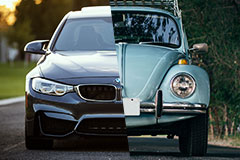Modern Cars Vs the 20th Century's Finest - Vol.402
From the list of impossible things to do, comparing old versus new cars is probably the favorite choice of every honest car enthusiast out there. It is emotional and highly enjoyable. A good opportunity to evoke memories of "happier times" and complain about the current events. Also, it is a chance to show off all that knowledge that has collected over time.

Interesting fact about all cars, both old and new, is that they are still basically the same. This, of course, does not include the much-praised electric cars, but let us not discuss them here. Let's think of them as something waiting for us in the very near future.
Are There Any Differences?
So, what happens when you start your brand new car? The mixture of fuel and air ignites and explodes inside the cylinders. The pressure of exploding gases pushes the pistons causing the crankshaft to rotate and provides wheels with power through the transmission. It is the exact same process used on the first car ever.
However, when it comes to cars, the difference between the new and the old is much like the difference between a modern man and a man from ancient Greece, for example. Both look, eat, sleep, walk, breathe and think.
But, if you would give to the ancient Greek a computer he probably wouldn't know what to do with it. The same goes for cars. They all have four wheels, internal combustion engines, and a transmission, but you could not say the same about the air conditioning or the GPS. Because of the advance of technology, many essential car features are constantly improved, while new features keep being added.
The 20th century was definitely the golden era of the internal combustion engine. During its course, cars became a symbol of progress. By the end of the century, cars reached every corner of the globe, impacting the lives of billions.
New Vs. Old
Nowadays, when we are at the beginning of a new car age, it is interesting to see how the most modern cars compare to the ones of yesteryear. This time we can leave the classic cars aside and take a look at those closer to us in time. The proud representatives of 1980's and the 1990's. Let's take a look at some similarities and differences through several categories.
1. Safety
- Airbags have been around for a while but have only become standard in the last years of the 20th century. Side airbags and side-curtain airbags are a feature found only in modern cars though.
- Forward Collision Warning (FCW) and Pedestrian detection are also systems which were not available in the 80's and 90's.
- Rear-view camera, tire pressure control, and Lane-departure warning (LDW) are just some of many systems which definitely make modern cars safer.
2. Design
This category is a tricky one. The nostalgic, old car lovers will say that the design was way more diverse back in the day and that modern cars look a lot like each other. Those who support newer cars will state that even the materials used to build cars today are better and more advanced. So, we have to call it a tie here.
3. Fuel efficiency
- When it comes to fuel efficiency, we really haven't made any significant progress during the last three or four decades. This seems like a story told and new technologies will have to take over in the future.
4. Dashboard, Controls and Entertainment
- Internet was not around in the 80's and most of us remember it's version from the 90's. Today, internet has penetrated every area of life. Modern cars have in-car Wi-Fi, enabling the use of all those smartphones, in-dash apps, and touch-screens.
- Multi-function steering wheel is another new feature found in today's cars only.
- On the other hand, some prominent car features have also been lost. Keys certainly top this list along with spare tires, radio antennas, big trunks, and ashtrays.
Closing Words
Times past always look happier and better when we evoke old memories. The same applies to old cars. They generally look better in your memory than in reality.